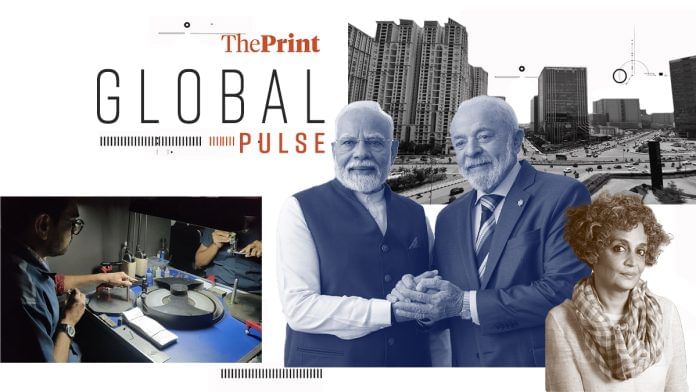New Delhi: US President Donald Trump’s tariffs go far beyond trade enforcement –– they are a tool of “political coercion” and India is not the only country in the line of fire, according to Brazilian political scientist Matias Spektor in The New York Times.
Brazil is also suffering, with their 50 percent tariff serving as an attempt by Trump to get the Lula government to drop charges against former President Jair Bolosonaro. Other than the tariffs, what the two nations also have in common is resistance, he writes.
“If Brazil and India successfully weather Mr. Trump’s tariffs, they’ll prove American economic coercion can be resisted and other countries will almost certainly develop their own hedging strategies,” Spektor writes.
“The outcome, though, won’t be a new world order but managed disorder — a return to the messy multipolarity of the early 20th century, when multiple powers and weak international institutions ultimately laid the foundations for world war.”
The Financial Times’ Andres Schipani and Krishn Kaushik also delve into India’s refusal to bow down to the tariff-induced pressure as it “holds firm on its longstanding ties with Moscow”.
“Amid the stalemate with Washington, top Indian officials have made a series of recent trips to Russia. Foreign minister Subrahmanyam Jaishankar met President Vladimir Putin last week in Moscow, where Indian national security adviser Ajit Doval was also warmly received. Putin is expected to visit India later this year,” states the report.
Chietigj Bajpaee, a senior research fellow at the Chatham House, has been quoted as telling the FT that New Delhi and Washington are stuck in a game of “who will blink first”.
Also in the Financial Times, Krishn Kaushik and Chris Kay report on the “unsustainable boom” in India’s Silicon Valley––Bengaluru––which is now being weighed down by its bevy of infrastructural issues. The “global race” for Artificial Intelligence is also weighing on the city, as global giants employ “hundreds of thousands of Indians” to buttress their operations.
“That build-up has choked Bengaluru. The city has become prone to annual flooding and its once benign climate is becoming noticeably hotter thanks to the reduction of its green cover and impact of climate change, with the city’s development severely lagging behind its population influx,” says the report.
“We need to pull up our socks on a lot of issues plaguing the industry, but that’s a problem with every growing city,” Karnataka IT Minister Priyank Kharge tells the FT. “We are also encouraging people to go beyond Bengaluru.”
But it is an “uphill task” to convince many residents, he goes on to say. “The problem is people love Bangalore. People love the weather, people love the social life that comes with it.”
The Guardian has an excerpt from writer Arundhati Roy’s latest, Mother Mary Comes To Me, which is due to hit stores next week. A memoir, the book chronicles her relationship with her mother, teacher Mary Roy.
“We arrived in Ayemenem uninvited and manifestly unwelcome. The house whose doorstep we appeared on with our invisible begging bowl belonged to my grandmother’s older sister, Miss Kurien. She would have been in her 60s then. Her thin, wavy grey hair was cut in a style that used to be called a pageboy. She wore starched, papery saris with big, loose blouses. Miss Kurien was far ahead of most women of her time,” reads a portion of the excerpt –– which has been titled Arundhati Roy on her fugitive childhood: ‘My knees were full of scars and cuts – a sign of my wild, imperfect, fatherless life’
Ajay Lakum, a diamond worker in Surat is a “direct casualty” of the “escalating trade war” between India and the US, report Pranshu Verma and Supriya Nair –– looking into how the diamond industry is grappling with the shocks.
“The U.S. tariffs will completely destroy our industry,” Ramesh Zilriya, president of the Gujarat Diamond Workers Union tells The Post. He urged the American government “not to impose something that would ruin so many lives”.
“President Donald Trump’s 25 percent tariffs on India, which took effect on Aug. 7 and are set to climb to 50 percent on Wednesday, have brought this diamond town to a near-standstill, according to interviews with workers, merchants and industry analysts. Export orders are on pause,” states the report.
“Union leaders estimate 50,000 workers have been laid off since April, when Trump announced a 10 percent baseline duty on nearly all U.S. trading partners and first threatened higher rates on India. Other businesses that serve Surat’s diamond workers, from tobacco sellers to lunch stalls, are also in steep decline.”
(Edited by Ajeet Tiwari)
Also Read: Trump sends ‘valued’ aide to India amid discord & ‘heavy-handed’ regulation of online gaming






